Ball lightning is usually observed when thunderstorms are around. However, sometimes ball lightning is observed on perfectly nice days.
I prefer to call "ball lightning" "balls-of-light" because the Ball-of-Light Particle Model predicts they are the same thing. The Ball-of-Light Particle Model also predicts that the "ball lightning" observed here on earth -- sometimes -- has extraterrestrial origins.
The most common source of extraterrestrial ball lightning is from the sun. While less likely to be observed, some ball lightning may travel all of the way from distant stars. Since many scientists still do not believe in ball lightning, this may seem farfetched -- at first. However, not only is it possible -- in space at least -- balls-of-light are very common.
Most scientists will only go so far to admit that ball lightning is only possible for online RPG games and nothing else.
The sun has at least three potential mechanisms in the sun for creating ball lightning: prominences, induction off the sun's core, and sunspots.
To me, this is the least exciting of the three potential mechanisms the sun could use to make ball lightning, so I will cover it first to get it out of the way.
At times the sun creates huge prominences that arc over the surface of the sun. Prominences appear to follow the curves of magnetic field lines. Sometimes, the plasma from two prominences arc in opposite directions and collide head-on over the surface of the sun -- creating a shape kind of like that of a rainbow.
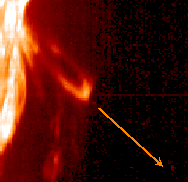
The Ball-of-Light Particle Model predicts that when the solar plasma follows the magnetic field lines of a sunspot from opposite directions and collides in the middle, the plasma could potentially create large balls-of-light. If such balls-of-light are created with the appropriate velocity (as the above image only implies), then they could potentially be ejected from the gravitational field of the sun.
If these ejected balls-of-light have stable harmonics, then they could survive as they travel through space away from the sun. (Nonstable harmonics would decay in the corona.) However, if these balls-of-light collide with something as they travel through space, chances are, the collision would destabilize the harmonics in the ball-of-light causing the ball-of-light to rapidly decay or explode. Colliding with a chunk of rock, a meteorite, a planet's moon, the atmosphere of a planet, or a planet itself could cause such a rapid decay. Some of the more harmonic balls-of-light might decay so slowly they could make it through the upper atmosphere of earth and be visible decaying in the sky from ground or from the air. They might even make it all of the way to the ground. (See also UFOs)
While ball lightning from prominences are possible, they do not seem as likely as ball lightning from the second and third mechanisms: induction off of the sun's core, and sunspots.
The second source of solar ball-lightning is the same mechanism that creates just about all of the material in the envelope of the sun and sunspots. (The only exception is a relatively small amount of matter that the sun gravitationally "accretes.")
First of all, the Ball-of-Light Particle Model predicts the core of the sun is one object as depicted in this diagram.
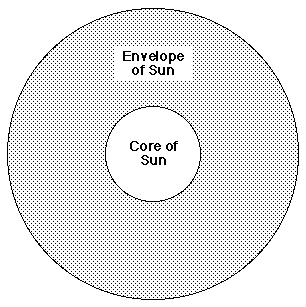
It predicts this object is a ball-of-light that is decaying. As the core decays, waves of electric and magnetic fields sweep over the surface of the core. These sweeping waves are normally harmonic and have a relatively small magnitude. They induce small balls-of-light -- such as normal atomic nuclei, electrons, and the various short-lived, low energy particles that scientists are able to create in particle accelerators. These waves on the core of the sun can also induce photons. (See also, The Induction of Matter.)
However -- sometimes -- when the electromagnetic waves are strong enough, larger particles are induced.
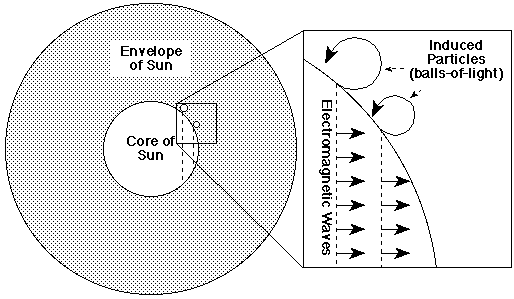
This graphic depicts a electromagnetic wave sweeping across the core of the sun from left to right. As it does, the fields induce new particles -- new balls-of-light -- as the fields curl off the core like chips of wood being peeled off a piece of wood with a plane.
(See also, Animation of an Induced Ball-of-Light)
On the average, the sun is always producing thousands, if not millions or more of these exotic, relatively large balls-of-light. However, this process of inducing larger balls-of-light occurs more often during the peaks of the 22 year solar cycle. More large balls-of-light are induced off of the sun's core when the sun is less stable. The Ball-of-Light Particle Model predicts that increased numbers in sunspots are an indication that the sun is less stable.
The balls-of-light that are induced by the sun's core can float up through the envelope of otherwise normal material that surrounds the core of the sun. Some can explode and cause Solar Eruptions (also called Solar Mass Ejections).
Some of these balls-of-light are approximately the size of a baseball. Some are medium-sized -- miles across. Some are large -- maybe even hundreds of miles across. In general, the Ball-of-Light Particle Model does not put a limit on their size. (In radio galaxies, the ejected balls-of-light are possibly millions of miles in diameter!) For the sun, these balls-of-light are always smaller than the size of the core.
The Ball-of-Light Particle Model predicts that solar eruptions are caused by a ball-of-light that explosively decays in the envelope of the sun. Because the decay happens below the solar surface, plasma above the exploding ball-of-light is ejected into space.
The Ball-of-Light Particle Model predicts that sunspots are relatively harmonic balls-of-light that are floating on the surface of the sun. The Ball-of-Light Particle Model predicts that magnetic field lines that surround a sunspot are a result of the magnetic fields from the ball-of-light. The magnetic fields in the ball-of-light are very strong and cause the weaker magnetic polarity of the surrounding plasma to align to the ball-of-light. Because the ball-of-light is stable -- that is, hardly decaying -- and floating on the surface of the sun, the local area around the sunspot is cooler and therefore optically darker. However, the sunspots can be inducing smaller balls-of-light themselves. These smaller balls-of-light can be ejected by the sunspot and suddenly decay producing many high energy x-rays and even gamma rays around the sunspot.
The Ball-of-Light Particle Model predicts that x-ray flashes in the Corona of the sun originate from exploding balls-of-light. The majority of these exploding balls-of-light are induced by the core of the sun, float to the surface, are ejected into the corona -- possibly by electromagnetic repulsion -- and explode because they are not completely harmonic.
The Ball-of-Light Particle Model predicts that Solar Granulation is originally caused by the electromagnetic waves on the core and, and enhanced by the balls-of-light that are bubbling up through the outer envelope of the sun.
Graphic of Solar Granulation
The Ball-of-Light Particle Model predicts that "Blinkers" -- which are explosions the size of earth observed on the surface of the sun -- come from exploding balls-of-light that are in the large category!
As these balls-of-light bubble up through the envelope of the sun, they can explode. When they explode depends on how stable they are:
It is an observational fact that sunspots are dark compared to the rest of the sun. It is an observational fact that the amount of total light that the sun gives off varies in a cyclic pattern. Sometimes the sun gives off more radiation, sometimes it gives off less radiation. You might expect the sun would give off less radiation when it is covered by sunspots -- because they are dark -- and more radiation when there are no sunspots. The Ball-of-Light Particle Model predicts the opposite. Indeed, it turns out the sun is more luminous when there are more sunspots.
The Ball-of-Light Particle Model predicts a sunspot is a ball-of-light that was originally induced by the core of the sun that subsequently floated to the sun's surface. Because the ball-of-light is stable -- that is, slowly decaying -- and floating on the surface of the sun, the local area around the sunspot is cooler -- on the order of 1700 degrees Kelvin -- and therefore is optically darker. The magnetic fields in the ball-of-light are very strong -- on the order of 2,000 to 3,000 gauss -- and cause the weaker magnetic polarity of the surrounding plasma to align to the ball-of-light.
The Ball-of-Light Particle Model predicts that one pole of the sunspot will be more magnetically attracted to the core of the sun than the other and therefore the pole of the sunspot will be tilted with respect to the surface of the sun.
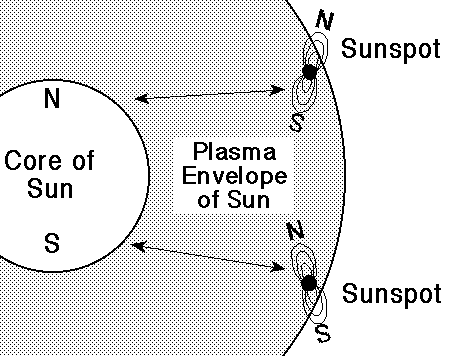
This "tilt" creates the shape in the surrounding ionized plasma. The pole angled down into the plasma will appear larger in surface area but weaker in intensity. The pole angled up in the plasma will appear smaller in surface area but more intense.
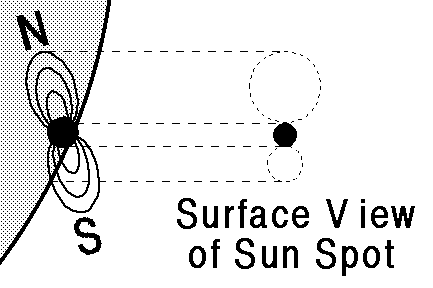
The ionized plasma will follow the electric field lines up over the floating ball-of-light. This creates lines around sunspots called Penumbra.
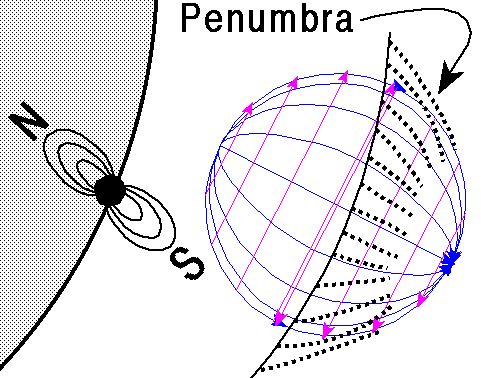
Sunspots can simply vanish because they can slowly decay. I call this decay mode, "the fizzle." Sunspots also can explode, or split, sometimes ejecting smaller balls-of-light. An ejected ball-of-light might come off either pole of the sunspot. Thus, an ejected ball-of-light might be shot off angled down into the sun's plasma, or up into the sun's atmosphere.
"The dark core is stirred by movements of matter (hot rising structures with a diameter of about 200 kilometers), 'flashes', ..."
Page 38, Cambridge Atlas of Astronomy
(See also, Induction off of a Ball-of-Light's Pole)
An example of a decaying sunspot that ejected a smaller ball-of-light down an into the sun's plasma was recorded by the SOHO satellite. This smaller ejected ball-of-light subsequently explosively decayed which created a solar mass ejection.
A very cool SOHO animation of exploding sunspot (389K QuickTime.mov)

If you don't wish to download the above animation of an exploding sunspot, this is an image taken from that event. The center of the sunspot is located by the white arrow.
Another very cool SOHO animation of an exploding sunspot (289K QuickTime.mov)
The very strong magnetic field of the sun controls the less strong magnetic field of the sunspot ball-of-light. Its magnetic orientation can be seen in the plasma on the surface of the sun. It may be a little difficult for you to see the magnetic field lines in the image above, so I placed a double-headed black arrow in the image parallel to the sunspot's magnetic field lines but above where they are in the image. The Ball-of-Light Particle Model predicts they originate from the magnetic fields on the ball-of-light.
Here is a copy of a ball-of-light to review the magnetic field lines. On the left hemisphere, the magnetic field lines are coming out of the monitor at the bottom and are curving into the monitor at the top. On the right hemisphere, the magnetic field is coming out of the monitor on the top, and is curving into the monitor on the bottom.
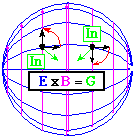
A better image of a sunspot and its related magnetic field lines can be seen in the following image.
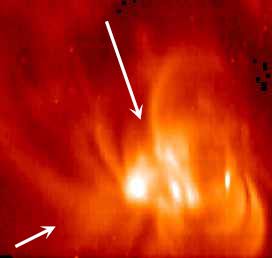
This ball-of-light is floating under the surface of the sun. Its location is approximately at the intersection of the two white arrows. The poles of the ball-of-light are approximately aligned parallel to the shorter arrow.
Balls-of-light can be seen when the explode after escaping the envelope. Sometimes, they are described as mysterious solar flashes or Blinkers.